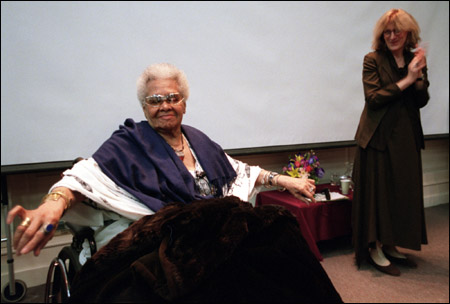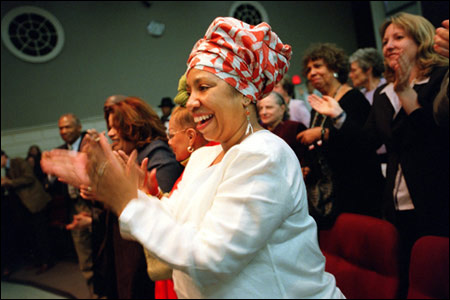Cozy chat with a dance legend:
Matriarch of black dance Katherine Dunham speaks at GSE

Rich with nearly a century of collected wisdom on art, activism, and finding a purpose in life, the talk by dance legend and anthropologist Katherine Dunham at the Graduate School of Education (GSE) Wednesday night (April 30) felt more like a cozy chat with Grandma than a formal academic lecture.
Of course, not everyone’s grandma holds the Presidential Medal for the Arts, the Kennedy Center Honors, lifetime achievement awards from the NAACP and the Urban League, and honorary degrees from Harvard and other institutions as well as a Ph.D. from the University of Chicago.
Most grandmothers aren’t credited with the creation of a major art form, as Dunham is with black dance in the United States, and few can claim a legacy that includes film and theater credits, an acclaimed performing dance company, and several schools of dance. And not many grannies remain politically active into their sunset years, protesting America’s relations with Haiti with a 47-day hunger strike – at age 82.
Still, Dunham, who kept a positive perspective even when discussing the decline of civilization, was as gently feisty as any good grandmother would be at 93. And the audience, which included some of her cultural offspring, listened respectfully and adoringly like dutiful grandchildren.

Dunham’s talk was sponsored by the GSE’s Askwith Educational Forum and the Arts in Education Program’s John Landrum Bryant Performance-Lecture Series. Introducing Dunham, Jessica Davis, the Patricia Bauman and John Landrum Bryant Senior Lecturer on Arts in Education, called her “the matriarch of black dance,” lauding her for blending the scholarly study of cultural anthropology to the artistic genre of dance.
Widely credited for introducing an Afro-Caribbean movement vocabulary to modern dance and ballet, Dunham’s work opened the door for companies like the Alvin Ailey American Dance Theater and Dance Theater of Harlem.
‘A good way to live’
“It’s not what I have done, but what has been done to me or done on me,” Dunham responded to Davis’ accomplishment-heavy introduction. “My life is made up of people acting with me. I’m finding it’s a good way to live.”
Just a month shy of her 94th birthday, Dunham looked forward wryly as she reflected. “I have no idea what it will be like to be 94,” she said. “I’ll be here until I’m not here.”
The author of several books on her anthropological observations and a yet-unfinished memoir, Dunham was ushered onto the stage by costumed African drummers and dancers from the Hartford, Conn., Artists Collective, which traces its cultural lineage to her. They brought the crowd to its feet several times during the talk with their insistent drumbeats and contagious enthusiasm.
Speaking without notes, Dunham stressed the importance of living with a purpose.
“We’re only unhappy if we don’t have a purpose in life,” she said, adding that today’s issues provide more than ample opportunities for happiness. “There’s so much to live for now, there’s so much to fight for, it’s overwhelming.”
The triumph of humans’ destructive energy over love and creativity is leading our civilization into decline, she said.
“You can’t think this is the way man is supposed to live,” she said matter-of-factly. “It cannot be good to send young, still wet-behind-the-ears boys into battle.”
Education, knowledge, and care – for and about oneself as well as others – will keep at bay the forces of greed, jealousy, and possession that, she said, are consuming our society.
To the audience, which included educators as well as artists, Dunham issued strong statements about the importance of education and of raising children with less anxiety.
“There is a way that children can live in this world without the fear of being abandoned or misused or being separated from their mothers,” she said, drawing on her extensive world travel.
From her wheelchair, she amused the audience with her vivid pantomime of characters in children’s television programs, miming a frightening creature with fangs and horns.
A life in rhythm
Dunham’s talk was billed as a “conversation” with Davis, yet Davis was silent for nearly half an hour of unbroken commentary from her guest.
“This is one of the best interviews I’ve ever done,” she quipped before focusing the conversation on Dunham’s life in dance.
“I’ve always needed to move,” said Dunham. The daughter of a black father and white mother – “I don’t know how they had nerve enough to get together,” she said – she recalled dancing to her father’s guitar playing as a toddler.
“Somewhere in me was a kind of rhythm. It was connected to the Earth, it was connected to other people,” she said.
Her studies as an anthropologist, through which she developed an expertise in the West Indies and Haiti in particular, reinforced for her the importance of dance across cultures.
“I know of no society that does not have some form of national or ethnic dance,” she said.
Following Dunham’s remarks and audience questions, words gave way to movement. Artists Collective Executive Director Dolly McLean, a former student at the Dunham School in New York, presented a clip from the 1943 film “Stormy Weather,” featuring a dance segment by Dunham and her company.
“I haven’t seen that in years!” exclaimed Dunham of her first major film appearance.
Lee Aca Thompson, master choreographer with the Artists Collective and another former Dunham student, demonstrated movement from the Dunham Technique as the drummers accompanied with a rhythm from Haiti.
As Thompson, lithe and flexible at 69, finished his performance with a bow to Dunham, she obliged the jubilant crowd by shaking her shoulders in time to the drumming, an echo of the dance she made a legacy.




